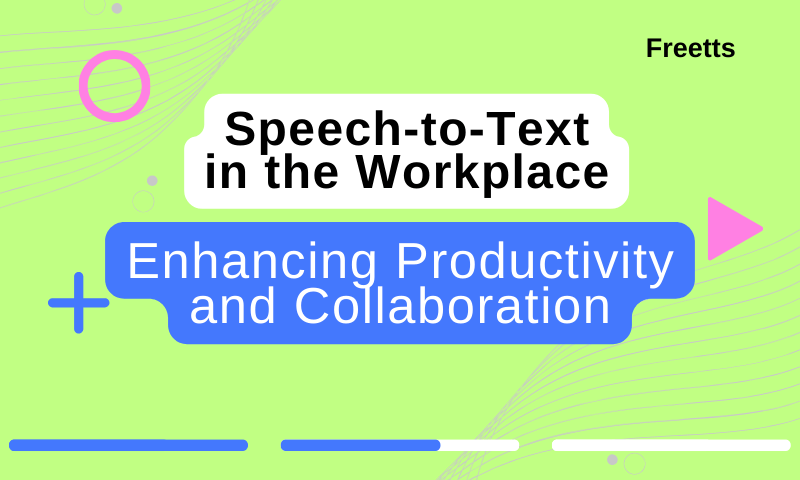Speech-to-Text in the Workplace: Enhancing Productivity and Collaboration

The workplace has transformed dramatically over the years, thanks to technological advancements. In the quest for increased productivity and seamless collaboration, businesses are continually exploring innovative tools. One such technology making waves is speech-to-text.
Imagine turning your spoken words into written text in real-time—how much more could you accomplish? This technology not only boosts productivity but also fosters a more collaborative environment.

What is Speech-to-Text Technology?
Speech-to-text, also known as voice-to-text, is a technology that converts spoken language into written text. This isn't a new concept; it has its roots in early dictation machines. However, recent advancements have made it more accurate and accessible, transforming how we work.
How Speech-to-Text Works
The magic behind speech-to-text lies in voice recognition software and Natural Language Processing (NLP). Voice recognition software captures spoken words, while NLP analyzes and transcribes these words into text. It’s like having a personal assistant who never tires of taking notes.

Benefits of Speech-to-Text in the Workplace
The benefits of speech-to-text are vast, particularly when it comes to improving workplace efficiency and collaboration. Here are some ways it can enhance your work environment:
- Time-saving – Skip the typing and let your voice do the work.
- Improved accuracy – No more worrying about typos or misspelled words.
- Increased accessibility – It allows employees with disabilities to engage more easily.
- Real-time transcription – Capture meeting notes instantly.
- Multitasking – Talk while your computer transcribes.
Improving Productivity through Automation
At its core, speech-to-text is an automation tool. By allowing workers to speak their thoughts rather than type them out, the tool reduces the time spent on manual tasks like writing reports or emails. This automation provides an immediate productivity boost, as it removes barriers that can slow down processes.
Imagine having a 10-minute brainstorming session, where you simply speak and the system transcribes your ideas. You can then quickly sift through the text, reorganize it, and move on to the next task. The time saved accumulates, making room for higher-value activities.

How Speech-to-Text Saves Time
We’ve all been there – frantically typing during a meeting or interview to make sure we don’t miss any critical points. With speech-to-text, you can focus on the conversation while the software handles the transcription. This eliminates the need for manual note-taking and allows employees to spend their time more effectively.
The ability to dictate instead of typing also significantly speeds up processes like email composition, report generation, and document drafting.

Real-World Applications in Business
The use of speech-to-text goes beyond just meeting transcription or email writing. Here are some real-world applications that businesses are taking advantage of:
- Customer service departments use speech-to-text to transcribe calls and create detailed records of interactions.
- Healthcare professionals utilize the technology for patient documentation, reducing time spent on paperwork.
- Law firms can transcribe depositions, allowing for faster case preparation.
- Marketing teams use speech-to-text to capture creative ideas during brainstorming sessions, eliminating the need for manual note-taking.

Tips for Maximizing Speech-to-Text Effectiveness
While speech-to-text is an incredibly useful tool, it's not without challenges. Factors like background noise, accents, and the speed of speech can sometimes affect accuracy. However, many modern speech-to-text tools now come with features such as noise cancellation and the ability to learn specific accents, which significantly improves performance.
Investing in high-quality microphones and encouraging employees to speak clearly can also help overcome these hurdles.
Speech-to-Text and Remote Work
With remote work becoming more commonplace, speech-to-text has found a new home in virtual workspaces. Remote employees often need to juggle multiple tasks, and speech-to-text allows them to remain productive without being tethered to a keyboard.
For instance, during video calls, speech-to-text can automatically transcribe the conversation, ensuring that nothing important is missed. This is especially useful for workers in different time zones, who can quickly review transcripts from meetings they couldn’t attend in real-time.

Enhancing Meetings with Speech-to-Text
Meetings are essential to any workplace, but they can often feel inefficient, especially when time is wasted on writing notes. Speech-to-text improves this process by transcribing discussions in real-time, allowing everyone to focus on the conversation rather than the note-taking.
In addition, recorded transcripts provide a reliable record of the meeting, so there’s no confusion about what was said or decided. This leads to fewer follow-up meetings and more actionable outcomes.

The Human Element in Speech-to-Text Technology
While automation is fantastic, the human touch is irreplaceable. Balancing technology with human interaction ensures a more emotionally intelligent approach to communication. Technology should augment, not replace, human efforts.
Speech-to-Text and Inclusivity
Inclusivity is crucial in today’s diverse workplaces. Speech-to-text supports this by providing accessible communication options for employees with disabilities. It levels the playing field, allowing everyone to contribute equally.

The Future of Speech-to-Text in Business
As artificial intelligence continues to evolve, so too will speech-to-text technology. Future advancements could include more natural language understanding, enhanced context awareness, and even the ability to recognize individual speakers in group settings.
Looking ahead, speech-to-text will likely become an even more integral part of the workplace, helping to boost productivity, streamline communication, and create more inclusive environments.
Conclusion
Speech-to-text technology is revolutionizing the workplace. Its ability to enhance productivity, improve collaboration, and support inclusivity makes it a valuable tool for any business. Embracing this technology today can lead to significant long-term benefits.

FAQs
What is the accuracy rate of speech-to-text technology?
The accuracy rate varies depending on the software and conditions but can be as high as 95-99% under optimal conditions.
How does speech-to-text improve collaboration?
It facilitates real-time communication and information sharing, ensuring that all team members have access to the same information instantly.
Are there any privacy risks associated with speech-to-text tools?
Yes, but choosing tools with robust security measures and compliance with privacy regulations can mitigate these risks.
Can speech-to-text technology understand multiple languages?
Many advanced speech-to-text tools support multiple languages, making them versatile for global teams.
What is the future potential of speech-to-text in the workplace?
With advancements in AI and NLP, speech-to-text will become more accurate and versatile, further integrating into various workplace applications.

